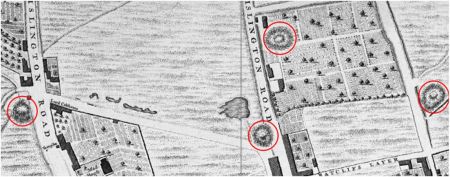Bad winter weather with bitter cold and thick fogs spread across London during January 1730. As a result there were several sudden deaths and accidental injuries. The Bill of Mortality for the week commencing 6 January shows only two sudden deaths: a child ‘found dead’ in the church yard of St Mary Magdalen in Bermondsey and another person reported as ‘murdered in the goal’ at St George Southwark. This last death was that of a newborn infant deliberately drowned by Sarah Townshend, the mother, who was at the time a felon ‘committed to the New Gaol’.
The following week’s Bill has a greater and more varied number of casualties. Published for the week commencing the 13 January the Bill reports six deaths:
1 killed accidentally by a fall at St Dunstan in the West;
2 drowned: one at St Mary Lambeth; one at St Martin in the Fields;
2 found dead: one, a girl, in the churchyard of Christchurch Spitalfields; one, a male infant, at St George in the East [Wapping];
1 hanged herself being lunatic at St James Westminster.
But of course there were also those who evaded death yet still received injury at this difficult time of year. The Daily Courant newspaper took great delight in reporting on Thursday 8 January 1730 that:
The same evening [Tuesday 6th], during the time of the prodigious fogs, a man mistaking his way, fell into the fleet ditch, by which accident he beat out one of his eyes, and was very much bruised.
Another man fell into the Common-shore [sewer] in King Street, Westminster; and a great many more accidents happened on the like occasion, both in the streets of London and Westminster; as also on the River Thames.
Perhaps the most interesting story of that edition is the one that refers to beer. While the labourer concerned received no injury it is his particularly close encounter with death, and escape, that made the event so newsworthy to the metropolitan readership:
The same day, a house pretty much out of repair in Bedfordbury fell down; a bricklayer’s labourer who was employed to pull off the pantyling to lighten it, had got off about 200 [tiles], and was gone to get himself a pint of beer being cold, when it fell down without doing any further damage.

